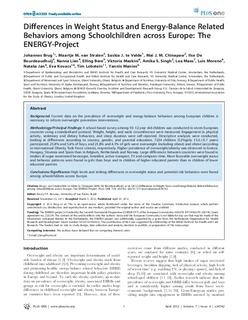| dc.contributor.author | Brug, Johannes | |
| dc.contributor.author | van Stralen, Maartje M. | |
| dc.contributor.author | te Velde, Saskia J. | |
| dc.contributor.author | Chinapaw, Mai J. M. | |
| dc.contributor.author | De Bourdeaudhuij, Ilse | |
| dc.contributor.author | Lien, Nanna | |
| dc.contributor.author | Bere, Elling | |
| dc.contributor.author | Maskini, Victoria | |
| dc.contributor.author | Singh, Amika S. | |
| dc.contributor.author | Maes, Lea | |
| dc.contributor.author | Moreno, Luis | |
| dc.contributor.author | Jan, Nataša | |
| dc.contributor.author | Kovacs, Eva | |
| dc.contributor.author | Lobstein, Tim | |
| dc.contributor.author | Manios, Yannis | |
| dc.date.accessioned | 2012-08-02T09:00:36Z | |
| dc.date.available | 2012-08-02T09:00:36Z | |
| dc.date.issued | 2012 | |
| dc.identifier.citation | Brug, J., van Stralen, M. M., te Velde, S. J., Chinapaw, M. J. M., De Bourdeaudhuij, I., Lien, N., . . . Manios, Y. (2012). Differences in weight status and energy-balance related behaviors among schoolchildren across Europe: The ENERGY-Project. PLoS ONE, 7(4), 1-13. doi: 10.1371/journal.pone.0034742 | no_NO |
| dc.identifier.issn | 1932-6203 | |
| dc.identifier.uri | http://hdl.handle.net/11250/139019 | |
| dc.description | Published version of an article published in the journal: PLoS ONE. Also available from the publisher at: http://dx.doi.org/10.1371/journal.pone.0034742 | no_NO |
| dc.description.abstract | Background: Current data on the prevalence of overweight and energy-balance behaviors among European children is necessary to inform overweight prevention interventions.
Methodology/Principal Findings: A school-based survey among 10–12 year old children was conducted in seven European countries using a standardized protocol. Weight, height, and waist circumference were measured; Engagement in physical activity, sedentary and dietary behaviors, and sleep duration were self-reported. Descriptive analyses were conducted, looking at differences according to country, gender, and parental education. 7234 children (52%girls; 11.6±0.7 years) participated. 25.8% and 5.4% of boys, and 21.8% and 4.1% of girls were overweight (including obese) and obese (according to International Obesity Task Force criteria), respectively. Higher prevalence of overweight/obesity was observed in Greece, Hungary, Slovenia and Spain than in Belgium, Netherlands and Norway. Large differences between countries were found in intakes of sugar-sweetened beverages, breakfast, active transport, TV and computer time. More favorable overweight status and behavior patterns were found in girls than boys and in children of higher educated parents than in children of lower educated parents.
Conclusions/Significance: High levels and striking differences in overweight status and potential risk behaviors were found among schoolchildren across Europe. | no_NO |
| dc.language.iso | eng | no_NO |
| dc.publisher | Public Library of Science | no_NO |
| dc.title | Differences in weight status and energy-balance related behaviors among schoolchildren across Europe: The ENERGY-Project | no_NO |
| dc.type | Journal article | no_NO |
| dc.type | Peer reviewed | no_NO |
| dc.subject.nsi | VDP::Medical disciplines: 700::Health sciences: 800::Nutrition: 811 | no_NO |
| dc.subject.nsi | VDP::Medical disciplines: 700::Health sciences: 800::Community medicine, Social medicine: 801 | no_NO |
| dc.source.pagenumber | 1-13 | no_NO |
| dc.source.volume | 7 | no_NO |
| dc.source.journal | PLoS ONE | no_NO |
| dc.source.issue | 4 | no_NO |
